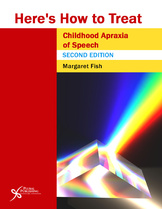Publication
Here's How to Treat Childhood Apraxia of Speech
- Second Edition
- Details:
- 446 pages, Illustrated (B/W), Softcover, 8.5 x 11"
- ISBN13:
- 978-1-59756-617-9
- Release Date:
- 09/30/2015
Overview
Here's How to Treat Childhood Apraxia of Speech, Second Edition is the most comprehensive book available that addresses assessment, diagnosis, and treatment of childhood apraxia of speech (CAS). This text is the definitive reference for professionals and students seeking current best practices in treating children with CAS.
The book is divided into three parts. Part I defines CAS, describing those characteristics most commonly associated with CAS, and offers guidelines for conducting a thorough motor speech evaluation to support an accurate differential diagnosis. Part II summarizes the principles of motor learning and provides clear guidance for how these principles can be applied to practice when working with children with CAS. Part III addresses specific topics of interest to clinicians and students looking for practical ideas to address the multifaceted challenges of children with CAS such as vowels, prosody, expressive language, social language, and incorporating phonological awareness in CAS treatment. Additional recommendations are provided for supporting the needs of children with limited verbal output and older children with ongoing communicative challenges, working with parents, developing treatment plans, and writing meaningful goals and objectives.
Each chapter of this second edition has been updated to incorporate the most current evidence-based information available on CAS. In addition, five new chapters have been added, including:
- Principles of Motor Learning and Their Application to Treatment of CAS (Chapter 4)
- Evidence-Based Treatment Programs for Children with CAS (Chapter 10)
- Supporting the Needs of Older Children with Ongoing Communicative Challenges (Chapter 15)
- Using Apps with Children with CAS (Chapter 21)
- Developing Meaningful Goals for Children with CAS (Chapter 23)
Here's How to Treat Childhood Apraxia of Speech, Second Edition will be of value to speech-language pathologists and students looking for practical, evidence-based recommendations for addressing the diverse needs of children with CAS.
This title is a volume in Plural's "Here's" How" series.
Reviews
Nancy R. Kaufman, MA, CCC-SLP, Director / Speech-Language Pathologist; Kaufman Children's Center for Speech, Language, Sensory-Motor and Social Connections, Inc. (2015):
"Here's How to Treat Childhood Apraxia of Speech, Second Edition is an incredibly comprehensive resource book, essential for SLPs! It is an informative, organized, friendly, current and most importantly practical resource, and one that I use often, even with my own extensive knowledge in CAS. Thank-you Dee Fish for your obvious Herculean effort to provide us with one all-encompassing book for both evaluation and treatment techniques for such a challenging disorder in children!"Katherine Cammack, Graduate Clinician, Speech-Language Pathology,, Saint Louis University (April 2016):
"". . .a blessing this semester with my clients with CAS. It has been a phenomenal resource to refer back to time and time over again since it is so clinically applicable.""
Foreword by Kathy J. Jakielski, PhD, CCC-SLP
Preface
Part I. Understanding CAS
Chapter 1. What is Childhood Apraxia of Speech?
Chapter 2. Characteristics of Childhood Apraxia of Speech
Chapter 3. Assessment of Children with Suspected CAS
Part II. Foundations of Effective Treatment for Childhood Apraxia of Speech: Principles of Motor Learning and P.R.I.S.M.
Chapter 4. Principles of Motor Learning and Their Application to Treatment of CAS
Chapter 5. Phoneme Sequencing
Chapter 6. Repetitive Practice
Chapter 7. Intensity of Services
Chapter 8. Selecting Target Utterances
Chapter 9. Multisensory Cueing and Feedback
Part III. Additional Considerations in Treatment of Childhood Apraxia of Speech
Chapter 10. Evidence-Based Treatment Programs for Children with CAS
Chapter 11. Addressing Vowel Accuracy
Chapter 12. Establishing Normal Prosody
Chapter 13. Facilitating Early Production of Phrases and Sentences
Chapter 14. Treatment Considerations for Minimally Verbal Children
Chapter 15. Supporting the Needs of Older Children with Ongoing Communicative Challenges
Chapter 16. Addressing Early Literacy Concerns in Children with CAS
Chapter 17. Augmentative Communication and Children with CAS
Chapter 18. Enhancing Social Language Skills in Children with CAS
Chapter 19. Special Considerations for Children with Autism Spectrum Disorders
Chapter 20. Incorporating Books and Music into Treatment
Chapter 21. Using Apps with Children with CAS
Chapter 22. The Changing Needs of Children Over Time
Chapter 23. Developing Meaningful Goals for Children with CAS
Chapter 24. Partnering with Parents to Maximize Treatment Outcomes
Appendix A. Reproducible Forms
Appendix B. Materials and Resources
Appendix C. Phonetic Symbols for American English Consonants, Vowels and Diphthongs
Glossary
Index
About The Author
Margaret Fish, MS, CCC-SLP, is a speech-language pathologist working in private practice in Highland Park, Illinois. She has more than 30 years of clinical experience working with children with severe speech-sound disorders, language impairments, and social language challenges.
Related Titles
Here's How Children Learn Speech and Language
185 pages, Illustrated (B/W), Softcover, 8.5 x 11"
Here's How to Do Stuttering Therapy
175 pages, Illustrated (B/W), Softcover, 8.5 x 11"
Fluency Disorders
632 pages, Illustrated (B/W), Softcover, 7 x 10"
Here's How to Do Early Intervention for Speech and Language
288 pages, Illustrated (B/W), Softcover, 8.5 x 11"
Here's How to Treat Dementia
Jennifer L. Loehr, Megan L. Malone
200 pages, Illustrated (B/W), Softcover, 8.5 x 11"
Here's How to Provide Intervention for Children with Autism Spectrum Disorder
Catherine B. Zenko, Michelle Peters Hite
184 pages, Illustrated (B/W), Softcover, 8.5 x 11"















